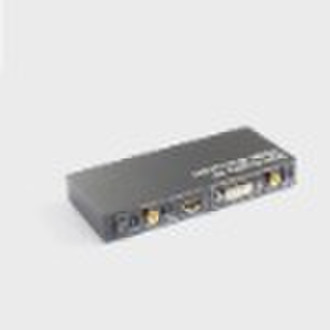Catalog
-
Catalog
- Agriculture
- Apparel
- Automobiles & Motorcycles
- Beauty & Personal Care
- Business Services
- Chemicals
- Construction & Real Estate
- Consumer Electronics
- Electrical Equipment & Supplies
- Electronic Components & Supplies
- Energy
- Environment
- Excess Inventory
- Fashion Accessories
- Food & Beverage
- Furniture
- Gifts & Crafts
- Hardware
- Health & Medical
- Home & Garden
- Home Appliances
- Lights & Lighting
- Luggage, Bags & Cases
- Machinery, Hardware & Tools
- Measurement & Analysis Instruments
- Mechanical Parts & Fabrication Services
- Minerals & Metallurgy
- Office & School Supplies
- Packaging & Printing
- Rubber & Plastics
- Security & Protection
- Service Equipment
- Shoes & Accessories
- Sports & Entertainment
- Telecommunications
- Textiles & Leather Products
- Timepieces, Jewelry, Eyewear
- Tools
- Toys & Hobbies
- Transportation
Filters
Search

HDMI Converter 1.2a With No Loss of Quality

Tony Maa
Contact person
Basic Information
| Place of Origin | Zhejiang China (Mainland) |
|---|---|
| Brand Name | Signal |
| Model Number | HD01CT02 |
Key Features 1.One HDMI input signal convert to one YPbPr+SPDIF or VGA+SPDIF sink device 2.HDCP 1.2 protocol compliant 3.Support audio output : SPDIF(Optical)+ R/L analog 4.Support output : Support up to UXGA and 1080I(50/60Hz),the same format as input 5.Support video input : HDMI 1.2a 6.LED indication : when source or sink is working, LED relative to is light 7.No loss of quality 8.Installs in minutes 9.Need DC5V/1A power supply Specifications HDMI version............................................ ....HDMI 1.2a Input Video signal........................................ 0.5 1.5Volts p-p Input DDC signal ..........................................5Volts p-p (TTL) VGA or YPbPr output......................................Support up to UXGA and 1080I(60Hz) Audio output..................................................R/L Analog and optical Max transmission bandwidth.........................5.1Gbps Max working current......................................600mA Power adapter format...................................Input:AC (50HZ, 60HZ) 100V-240V; Output: DC5V/1A Operating Temperature range.......................(-15 to +55°C) Operating Humidity range..............................5 to 90%RH (No Condensation) Dimension (L x W x H)....................................174x70x20 (mm) Weight...........................................................750g What is HDMI HDMI (High-Definition Multimedia Interface) is a compact audio/video interface for transmitting uncompressed digital data. It represents a digital alternative to consumer analog standards, such as radio frequency (RF) coaxial cable, composite video, S-Video, SCART, component video, D-Terminal, or VGA. HDMI connects digital audio/video sources—such as set-top boxes, upconvert DVD players, HD DVD players, Blu-ray Disc players, AVCHD camcorders, personal computers (PCs), video game consoles such as the PlayStation 3, Xbox 360, and AV receivers—to compatible digital audio devices, computer monitors, and digital televisions. HDMI supports, on a single cable, any uncompressed TV or PC video format, including standard, enhanced, and high-definition video; up to 8 channels of compressed or uncompressed digital audio; and a Consumer Electronics Control (CEC) connection. The CEC allows HDMI devices to control each other when necessary and allows the user to operate multiple devices with one remote control handset. Because HDMI is electrically compatible with the signals used by Digital Visual Interface (DVI), no signal conversion is necessary, nor is there a loss of video quality when a DVI-to-HDMI adapter is used. As an uncompressed connection, HDMI is independent of the various digital television standards used by individual devices, such as ATSC and DVB, as these are encapsulations of compressed MPEG video streams (which can be decoded and output as an uncompressed video stream on HDMI). The HDMI standard was not designed to include passing closed caption data (for example, subtitles) to the television for decoding. So any closed caption stream has to be decoded and included as an image in the video stream(s) prior to transmission over an HDMI cable to be viewed on the DTV. This limits the caption style (even for digital captions) to only that decoded at the source prior to HDMI transmission. This also prevents closed captions when transmission over HDMI is required for upconversion. HDMI products started shipping in late 2003. Over 850 consumer electronics and PC companies have adopted the HDMI specification (HDMI Adopters). In Europe, either DVI-HDCP or HDMI is included in the HD ready in-store labeling specification for TV sets for HDTV, formulated by EICTA with SES Astra in 2005. HDMI began to appear on consumer HDTV camcorders and digital still cameras in 2006. Shipments of HDMI were expected to exceed that of DVI in 2008, driven primarily by the consumer electronics market.
Delivery terms and packaging
Packaging Detail: color box or neutral packing Delivery Detail: 5-25 days after confirming the 30% deposit from buyer
Port: Shanghai or Ningbo
Payment term
Letter of credit
Telegraphic transfer
-
Payment Methods
We accept:








